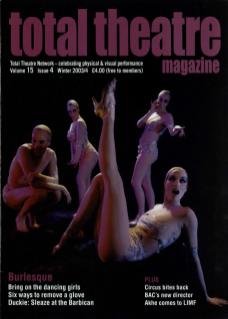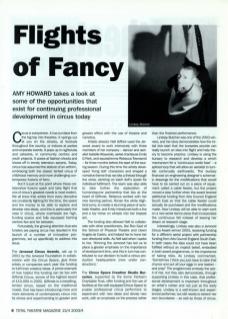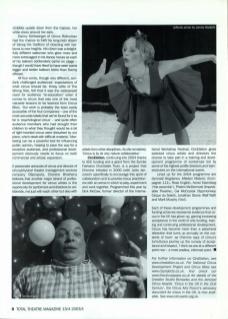Circus is everywhere. It has tumbled from the big top into theatres. It springs out at you on the streets, at festivals throughout the country, or indoors at parties and corporate events. It pops up in nightclubs and cabarets, in community centres and youth projects. It poses at fashion shoots and shows off in trendy television adverts. Today, circus has assumed the stature of an artform, embracing both the classic tented circus of childhood memory and more challenging contemporary fusions of form.
But it is just at the point where these collaborative fusions spark and take flight that one of circus' greatest needs is most evident. We all know that artists from every discipline are constantly fighting for the time, the space and the money to be able to explore and develop new ideas, and this is particularly the case in circus, where overheads are high, funding scarce and fully equipped training centres few and far between.
Fortunately, the growing attention that arts funders are paying circus has resulted in the launch of a number of innovative programmes, set up specifically to address this issue.
The Jerwood Circus Awards, set up in 2001 by the Jerwood Foundation in collaboration with the Circus Space, give three artists or companies each year the funding to fulfil their creative ideas. A prime example of how helpful this funding can be lies with Giffords Circus, winner of the highest award of £10,000 in 2002. Giffords is a travelling, tented circus, based on the traditional model, that has been introducing more and more elements of contemporary circus into its shows and experimenting to greater and greater effect with the use of theatre and narrative.
Artistic director Nell Gifford used the Jerwood award to work intensively with three members of her company – dancer and aerialist Isabelle Woywode, aerial chanteuse Emily G Park, and equestrienne Rebecca Townsend – for three months before the start of the touring season. During this time the artists developed 'living doll’ characters and shaped a narrative theme that ran like a thread through the show, centring on each doll's quest for individual fulfilment. The team was also able to take further the exploration of human/equine partnership that lies at the heart of Giffords. Rebecca worked with her new dancing partner, Ronan the white Highland pony, to create a stunning piece of acrobatic theatre, and Emily introduced both a live and a toy horse on wheels into her trapeze act.
The funding also allowed Nell to collaborate with other practitioners, like Ron East of the School of Physical Theatre and clown Angela de Castro, and helped her to hone her own directorial skills. As Nell said when I spoke to her, 'Winning the Jerwood has led us to place a greater emphasis on the importance of development time, and this in turn has contributed to our decision to build a circus production headquarters (now under construction).'
The Circus Space Creation Studio Bursaries, supported by the Esme Fairbairn Charitable Trust, offer funding and the use of facilities at the well-equipped Circus Space to enable professional circus performers to experiment with new ideas and devise new work, with an emphasis on the process rather than the finished performance.
Lindsey Butcher was one of the 2003 winners, and her story demonstrates how the initial kick-start that the bursaries provide can really launch an idea into flight and help theory to become practice. Lindsey is using the bursary to research and develop a winch mechanism for a ‘continuous corde lisse' – a spliced loop that will allow an aerialist to tumble continually earthwards. The bursary financed an engineering designer's schematic drawings for the modifications that would have to be carried out on a piece of equipment called a cable feeder, but the project moved a step further when the award levered additional funding from Arts Council England South East so that the cable feeder could actually be purchased and the modifications made. Now Lindsey will be able to start work on a new aerial dance piece that incorporates the continuous fall instead of leaving her dream at research stage.
Interestingly, Lindsey was also a Jerwood Circus Award winner 2003, receiving funding for a different aerial project with partnership funding from Arts Council England South East. In both cases the idea could not have been fulfilled without an implicit belief, embodied in both award programmes, in the importance of taking risks. As Lindsey commented, ‘Sometimes I think you just have to take that chance and put all your eggs in one basket – and pray!' The programmes embody the spirit of risk, but they also demonstrate, through supporting Lindsey in this case, that professional development is important throughout an artist's career and not just at the early stages. Lindsey is a well-known and experienced performer, but still needs to stretch her own boundaries – as well as those of circus.
The National Circus Development Project has been designed to respond to the development needs of circus artists – but this time not solely in terms of artistic development. Piloted in 2002/03, NCDP was instigated by the Arts Council of England to address the difficulties that circus artists and companies were experiencing when it came to dealing with those annoying bits peripheral to the art itself – the fundraising, the business plans, the marketing...
Seven circus companies were selected, some more established, some in their infancy, and Chenine Bhathena, director of NCDP, worked with them over a year to help them develop creatively and to guide them in selling themselves more effectively to their public.
Four of the companies – Circus Ridiculoso, solo artist Matilda Leyser, Fledgling and The Wrong Size – needed time to create new work and the means to show that work in performance venues. Accordingly, they were each given £5000 seed funding to develop new pieces, showcased in several different venues across the UK under the banner 'Circus Bites'. They were afforded the rare luxury of going on tour without having to shoulder the administrative burdens that touring normally involves. They were given invaluable feedback from their audiences at the end of each show, and they had the chance to build relationships with regional venues that might usually be less inclined to host circus-based performance.
Each piece of work, though still in need of development, demonstrated how powerfully and with how much invention circus can be used (in conjunction with words, with music, with poetry, with rollerskating!) to illustrate and convey a narrative. Interestingly, three of the four companies used circus skills to comment on some of life's darker and more complicated subjects.
Matilda Leyser set herself the challenging task of fusing text with aerial skills. Her cloudswing represented a train, and she carried her audience with her on a spiritual and a physical journey, describing the landscape as it flew past the windows while probing the mental grief of losing a father. Her aim was to uncloak the ethereality that traditionally surrounds the circus aerialist, drawing the audience into intimacy rather than encouraging it to look up at the artist in distanced awe.
Fledgling, a young company that came together through working on Mamoloucos' theatre/circus production The Birds, wove tantalising flashes of aerial work into a piece of intricate and playful dance that was inspired originally from Holocaust writings but which seemed more an interpretation of the friendships that life causes us to make and break and all the happiness and grief that come with them.
The Wrong Size, too, based their piece on a text – Donna Williams' autobiography about the condition of autism – and set it within a ring of ice blocks that ironically contained echoes of the traditional circus ring. The two women represented the two opposing sides of their autistic protagonist's mind. While one skated round the ring, the other hung childlike upside down from the trapeze, her white dress around her ears.
Danny Schlesinger of Circus Ridiculoso had the chance to fulfil his long-held dream of taking the tradition of clowning with balloons to new heights. His clown was a delightfully diffident salesman who grew more and more extravagant in his dance moves as each of his balloon contenders came on stage – though I would have liked to have seen some bigger and better balloon tricks than Danny offered.
All four works, though very different, similarly challenged audiences' expectations of what circus should be. Kirsty Little, of The Wrong Size, felt that it was the widespread need for audience 're-education’ when it comes to circus that was one of the most valuable lessons to be learned from Circus Bites. 'Our work is probably the least easily accessible of the four companies – one of the most accurate labels that we've found for it so far is “psychological circus” – and quite often audience members who had brought their children to what they thought would be a bit of light-hearted circus were disturbed by our piece, which dealt with difficult material.’ Marketing can be a powerful tool for influencing public opinion, helping to pave the way for a receptive audience, and professional development obviously needs to focus on both commercial and artistic expansion.
A passionate advocate of circus and director of circus/physical theatre management services company CBprojects, Chenine Bhathena believes that another major strand of professional development for circus artists is the opportunity for performers and directors to collaborate, not just with each other but also with artists from other disciplines. As she remarked, ‘Circus is by its very nature collaborative.'
CircElation, continuing into 2004 thanks to ACE funding and a grant from the Esmée Fairbairn Charitable Trust, is a project that Chenine initiated in 2000 (with Leila Jancovich) specifically to encourage this spirit of collaboration and to provide circus practitioners with an arena in which to play, experiment and work together. Programmed this year by Dick McCaw, former director of the International Workshop Festival, CircElation gives selected circus artists and directors the chance to take part in a training and development programme of workshops led by some of the highest profile directors and trainers/tutors on the international scene.
Lined up for the 2004 programme are Gennadi Bogdanov, Mladen Materic (Compagnie 111), Rose English, Avner Eisenberg ("the eccentric'), Phelim McDermott (Improbable Theatre), Cal McCrystal (Spymonkey/ Cirque du Soleil), Jonathan Stone (Ralf Ralf) and Mark Murphy (Vtol).
Each of these development programmes and funding schemes represents evidence that circus in the UK has grown up, gaining increasing acceptance in the world of arts funding, training and continuing professional development. Circus has become more than a peripheral attraction that turns up annually on the outskirts of town: as Chenine says of circus' tumultuous journey up the runway of acceptance and respect, 'I think we are at a different point now – a more positive, informed point.'
For further information on CircElation, see www.circelation.co.uk. For National Circus Development Project and Circus Bites see www.cbprojects.co.uk. And check out www.thecircusspace.co.uk for details of the Creation Studio Bursaries and the Jerwood Circus Awards. 'Circus in the UK in the 21st Century', the Circus Arts Forum's advocacy document for circus in the UK, is now available. See www.circusarts.org.uk



